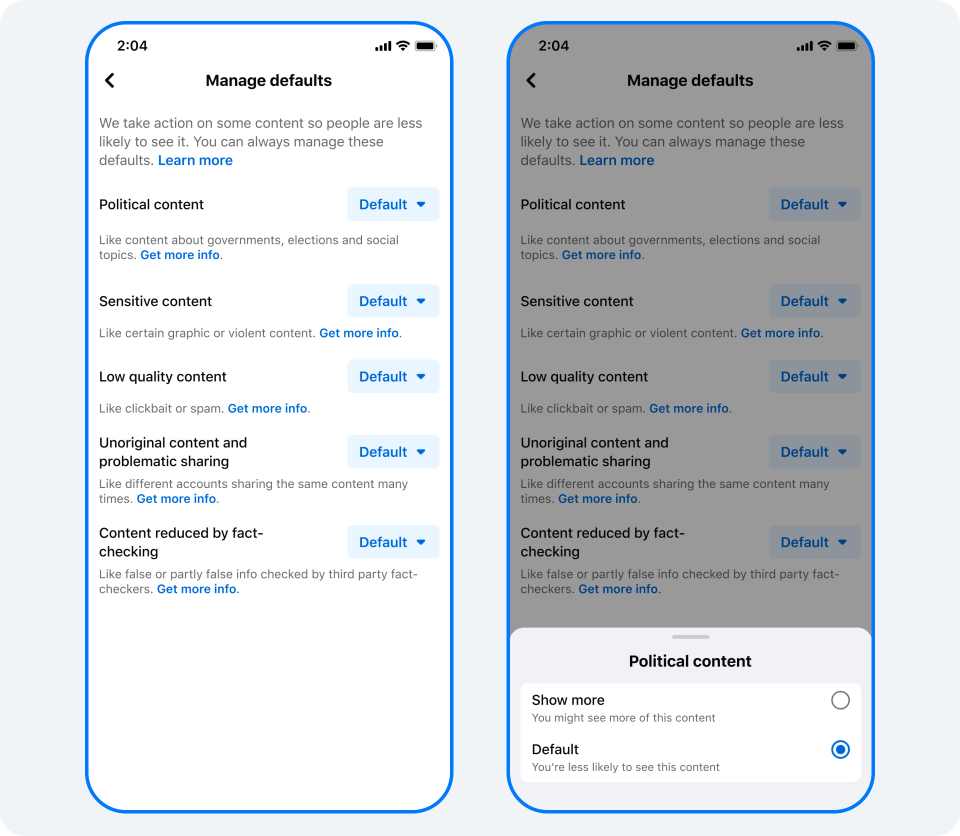By Anna Stepanov, Product Management Director and Aastha Gupta, Product Management Director
Update on May 28, 2025 at 9:00AM PT
We’ve updated our Help Center to better explain the Political Content control setting on Facebook. This setting allows people to see less political content if they choose by turning off the default option. For more on our approach to political content on Facebook, Instagram and Threads, please see our January announcement or visit the Transparency Center.
Update on January 7, 2025 at 4:10AM PT
We’re continually testing how we deliver personalized experiences and refining our approach based on feedback. Read our announcement here about how we’re updating our approach to political content.
Update on September 4, 2024 at 9:00AM PT
We have begun rolling out a Political Content setting on Facebook in Content Preferences. (Updated on April 25, 2025 at 1:40 PM PT to clarify that this setting is now found in Content Preferences instead of Manage Defaults.) Changing from the default setting may increase the amount of political content people see from accounts they follow, as well as increase political content recommendations from accounts they don’t already follow. This can be adjusted at any time in the Facebook Help Center. For more on our approach to political content on Facebook, Instagram and Threads, visit the Transparency Center.
Update on April 20, 2023 at 12:47PM PT
In an effort to deliver a more personalized experience for people, we continue to test and refine our approach to political content on Facebook. This includes continuing to move away from ranking based on engagement, and towards giving more weight to signals based on the results of user surveys that help our AI systems better understand people’s preferences by learning what is informative, worth their time or meaningful to them. We are also looking at things like comments on posts to help determine whether a post is political in nature and taking steps so people don’t see several posts about politics in a row.
This does not mean people will see more political content on Facebook, but we believe these — and future — tests will help us continue to show people the types of content they want to see.
While less than 3% of what people see in their Feed is political content, our goal is to make sure people see what’s most important to them. We do this by using direct and indirect feedback to customize each person’s experience so they see more of what they find valuable and less of what they don’t. We will keep sharing our progress as this work evolves.
Update on July 19, 2022 at 8:30AM PT:
Our tests have concluded and demonstrated that placing less emphasis on shares and comments for political content is an effective way to reduce the amount of political content people experience in their Feed. We have now implemented these changes globally.
Update on May 24, 2022 at 8:00AM PT:
As part of these tests to address feedback from people wanting to see less political content in their Feed, we put less weight on comments and shares when ranking political content. When surveyed, people who experienced these changes said they saw less of the content they did not find valuable. Based on those results, we’re further expanding tests globally. We’ll continue to share updates as we assess and refine these tests.
Update on December 9, 2021 at 9:00AM PT:
We are expanding our political ranking tests to Facebook Watch content. We will share more about the impact of these tests as they progress.
Update on October 13, 2021 at 12:00PM PT:
We are expanding the political content ranking tests to more countries around the world. As we get more insights from these tests, we’ll share updates on what we’re learning and will continue to make changes accordingly.
Update on August 31, 2021 at 8:00AM PT:
We’ve seen positive results from our tests to address the feedback we’ve received from people about wanting to see less political content in their News Feed. As a result, we plan to expand these tests to Costa Rica, Sweden, Spain and Ireland.
We’ve also learned that some engagement signals can better indicate what posts people find more valuable than others. Based on that feedback, we’re gradually expanding some tests to put less emphasis on signals such as how likely someone is to comment on or share political content. At the same time, we’re putting more emphasis on new signals such as how likely people are to provide us with negative feedback on posts about political topics and current events when we rank those types of posts in their News Feed.
We’ve learned that these changes will affect public affairs content more broadly and that publishers may see an impact on their traffic. Knowing this, we are planning a gradual and methodical rollout for these tests, but remain encouraged, and expect to announce further expansions in the coming months.
Update on February 17, 2021 at 10:55AM PT:
The initial tests to reduce the distribution of political content in News Feed are now live in the US for a small percentage of users.
Originally published on February 10, 2021 at 5:00AM PT:
As Mark Zuckerberg mentioned on our recent earnings call, one common piece of feedback we hear is that people don’t want political content to take over their News Feed.
Over the next few months, we’ll work to better understand peoples’ varied preferences for political content and test a number of approaches based on those insights. As a first step, we’ll temporarily reduce the distribution of political content in News Feed for a small percentage of people in Canada, Brazil and Indonesia this week, and the US in the coming weeks. During these initial tests we’ll explore a variety of ways to rank political content in people’s feeds using different signals, and then decide on the approaches we’ll use going forward. COVID-19 information from authoritative health organizations like the CDC and WHO, as well as national and regional health agencies and services from affected countries, will be exempt from these tests. Content from official government agencies and services will also be exempt.
To determine how effective these new approaches are, we’ll survey people about their experience during these tests. It’s important to note that we’re not removing political content from Facebook altogether. Our goal is to preserve the ability for people to find and interact with political content on Facebook, while respecting each person’s appetite for it at the top of their News Feed.
Based on our analyses in the US, political content only makes up about 3% (this number was updated on November 4, 2022) of what people see on Facebook. And although each person’s News Feed is different, we know even a small percentage of political content can impact someone’s overall experience. We already offer controls to help you manage what you see in News Feed, such as tools like Favorites which lets you select people and pages you want to prioritize in your News Feed; Snooze to temporarily hide posts from a person, page or group; and the ability to turn off political ads. But we’re always trying to make News Feed better, and this means finding a new balance of the content people want to see.
As we embark on this work, we’ll share what we learn and the approaches that show the most promise.




